Attractions of Karpacz
There is so much to see that you will want to stay longer
Karpacz is one of the most popular places to visit in Lower Silesia. It attracts tourists both in winter and summer, being one of the most popular holiday destinations in Poland. It is no wonder – it is an ideal base for conquering Śnieżka, the queen of the Sudetes. Additionally, for lovers of active recreation, there are over 100 km of picturesque hiking trails. Śnieżka and the Karkonosze Mountains are just some of the reasons why Karpacz enjoys such great popularity. There are numerous monuments on site, including the unique Wang Temple, museums and attractions for children. Even on rainy days, you will not be bored here. Karpacz is also a great base for exploring the surrounding towns of Lower Silesia. What is worth seeing in Karpacz and its surroundings?
The most popular attractions in Karpacz
along with the distances from Zielonego Wzgórza
Museum of Sports and Tourism (750m away)
The museum is located in the very centre of the town, in a historic 18th-century half-timbered house. It is here that you can delve into the history of settlement in the Karkonosze Mountains and learn about fascinating examples of local fauna and flora. Visitors will also learn how tourism developed in the region and what the beginnings of winter sports were, especially sledding.

Although the museum often promotes itself with information about Kamil Stoch’s skis, this is just one of many memorabilia related to famous athletes. There are many interesting facts to be found on site, which Krystyna Czubówna presents in an additionally paid audio guide (it’s worth using it!). Among the exhibits there is no shortage of historical models of skis, sledges, bobsleighs and numerous medals.
Promenade (350m away)
The promenade in Karpacz is part of Konstytucji 3 Maja Street, along which it is worth paying attention to several interesting places. The first of them is the Church of the Sacred Heart of the Lord Jesus, which was consecrated in 1908. The temple combines elements of neo-Romanesque and neo-Gothic, and originally served as an evangelical church. After World War II, it became a place of Catholic worship.
On the other side of the street there is a square with a fountain and a unique lime tree, called the Court Lime Tree. This impressive tree is 5 meters in circumference, reaches 22 meters in height and is over 250 years old. Its name refers to the old court trials that took place in its shade on hot days. When the weather did not allow it, cases were resolved in the nearby court inn.
Today, the building of the former inn, dating back to 1836, serves as a holiday home and the “Bachus” restaurant. Interestingly, Karpacz can boast as many as three court inns – the most in Poland. This is due to the fact that the town was created by combining several villages, settlements and estates.
The promenade in Karpacz begins right here and is full of life thanks to numerous restaurants, cafes and souvenir shops. Fans of the atmosphere of Zakopane’s Krupówki will certainly find something for themselves here.
On the right side of the promenade, there is a church tower with a characteristic onion-shaped dome. It belongs to the Church of the Visitation of the Blessed Virgin Mary, opened in 1910. The shape of the tower refers to the baroque architecture of Tyrol.
The promenade is also home to the Conquerors’ Traces Square – a local walk of fame. Over 20 bronze plates immortalize the footprints and names of outstanding Polish mountaineers. Many of these people are no longer alive, which makes this place even more important.
Karkonoskie Tajemnice (1km away)
Continuing your walk along Mickiewicza Street, it is hard not to notice an unusual figure. This fantastic creature has the head of a griffin with deer antlers, goat legs, spread wings, a long tail and is holding a staff. According to the oldest graphics, this is how the Spirit of the Mountains was depicted. The sculpture stands in front of the building that houses the Karkonoskie Tajemnice centre. Inside, there is an interactive exhibition, allowing both children and adults to learn about the legends associated with the Karkonosze Mountains and their mysterious guardian. Before entering the exhibition, the staff are happy to provide information on what to expect and what to pay special attention to. The exhibition is distinguished by its amazing atmosphere – the atmosphere is created by carefully selected light and sound effects. Additionally, visitors can enjoy multimedia screens and interactive games, which make learning about the history of the region even more engaging.
Dam on Łomnica (1.7km away)
At the end of the 19th century, Karpacz experienced a catastrophic flood that destroyed the railway line, numerous buildings, and farms. In order to prevent further natural disasters, the Łomnica River was regulated and a dam was built in the years 1910–1915. Its crest is 105 meters long, and the accumulated water creates a small lake with picturesque cascades.
The dam is located only 700 meters from the Karkonoskie Mysteries, and the walk to it leads through a park decorated with metal animal sculptures. It is a popular point on the tourist route – everyone who hikes the red Main Sudeten Trail passes here.
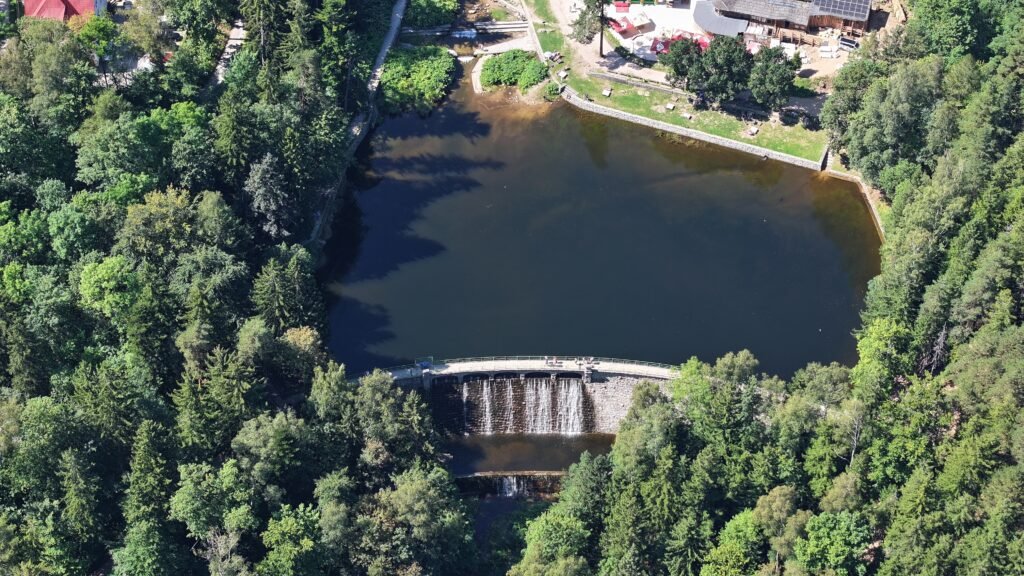
Wang Church (3,9km away)
The Wang Church, also known as the Wang Temple or the Mountain Church of Our Savior, is one of the most recognizable symbols of Karpacz, although its history reaches far beyond the borders of Poland. The church was built at the turn of the 12th and 13th centuries in the town of Vang, located in southern Norway. When, after many years, it turned out to be too small for the local community, it was decided to sell it.
The church was purchased by the King of Prussia, Frederick William IV, who bought it for 427 marks. After the transaction, the building was dismantled and transported in crates to Szczecin, and then to the Royal Museum in Berlin. Initially, it was planned to be rebuilt in the capital, but thanks to the efforts of Countess Fryderyka von Reden from Bukowiec, the church was reconstructed in Karpacz to serve the local Evangelical community.

The structure of the church refers to Viking boats and was built without the use of nails – from durable Norwegian pine wood. Only about 1/15 of the structure came to Poland from the original building, the rest was recreated based on drawings. During the reconstruction, cloisters and windows in them and in the internal walls were added, as well as a granite tower, which was to protect the church from strong winds.
The original entrance doors, four columns and rich decorations and inscriptions in runic script have survived to this day. The temple is picturesquely situated, and right next to it is an old church cemetery. One of the most famous people buried in this area is the poet Tadeusz Różewicz.
Śnieżka (7,7km away)
There is only one queen! Śnieżka, rising to a height of 1603 m above sea level, is the highest peak in the Karkonosze Mountains and the entire Sudetes. As in the case of Babia Góra, you can conquer it many times and still feel unsatisfied. Śnieżka lies on the Polish-Czech border, and its summit can be reached from both Poland and the Czech Republic.
If you are wondering which trail is best to climb Śnieżka, I recommend the yellow trail from the Wang Temple to Słonecznik, and then the red one to the Silesian House. From there, it is only a 40-minute walk to the top. This is definitely one of the most interesting and scenic routes. An alternative is the blue trail, which leads from the Wang Temple through the picturesque Samotnia to the Burnt Guardhouse. Then, all you need is a short section of the red trail to the Silesian House and then to Śnieżka.
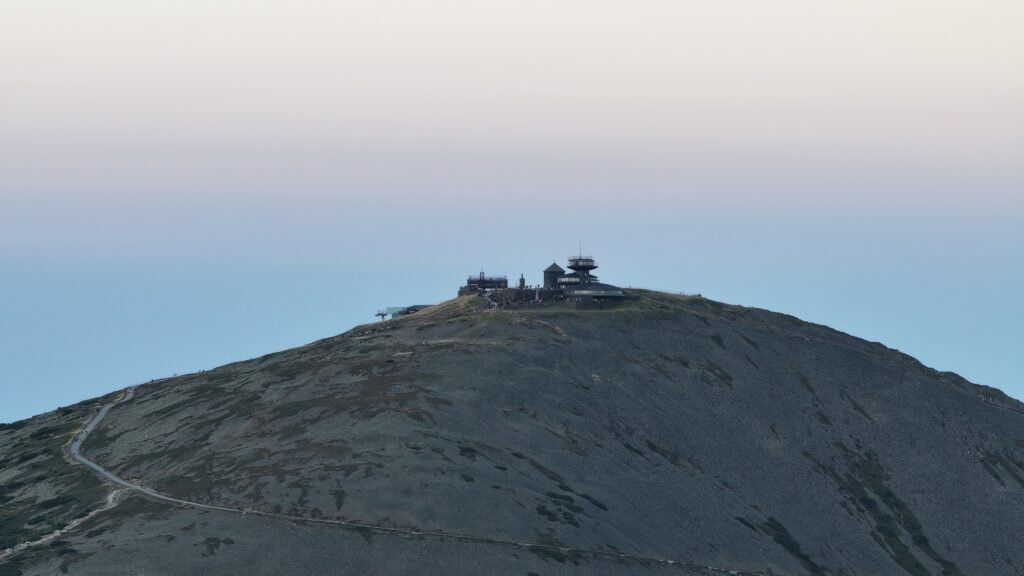
The easiest and fastest way to reach the top is to use the cable car to Kopa. From there, you can take the black trail to Przełęcz pod Śnieżką, and then – as in the previous variants – the red trail through Dom Śląski to the summit.
Rocky Table (6.5km away)
Continuing along the Polish-Czech Friendship Path, you will pass the Czech shelter Jelenka and reach Sowia Przełęcz. At this point, you will find a bypass of the blue trail leading to Skalny Stół.
Skalny Stół is the highest peak of the Kowarski Grzbiet, rising to 1,281 m above sea level. Although it is not as popular as Śnieżka, it offers fantastic views and attracts significantly fewer tourists. The peak offers a panorama covering Śnieżka, the eastern Karkonosze, Rudawy Janowickie, the Jelenia Góra Valley and the Kaczawskie Mountains.
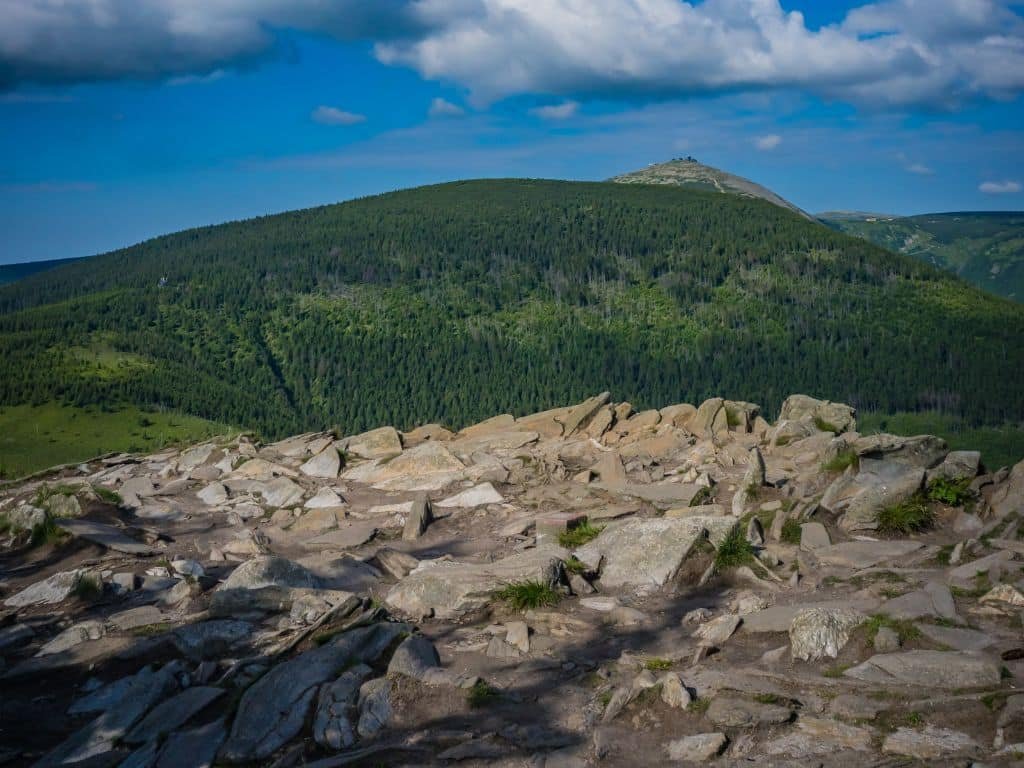
The shortest and easiest route to Skalny Stół is the blue trail leading from Przełęcz Okraj. Alternatively, you can set off from Kowary along the yellow trail. On the other hand, from Karpacz to Przełęcz Sowia, there is a black trail, from where you can continue your hike to the summit.
Toy Museum (1km away) and attractions for children
The Municipal Toy Museum in Karpacz is an attraction that will especially appeal to the youngest. It is located in the building of the former railway station, and its exhibition includes over 2,000 exhibits. The collection is based on the collection of Henryk Tomaszewski, the founder of the Wrocław Pantomime. Among the presented objects are toys from different corners of the world, and the dominant part is dolls. The museum also organizes temporary exhibitions, and an additional attraction is the Hall of Railway Tradition.
However, the Toy Museum and Karkonoskie Mysteries are not the only places in Karpacz that can interest children. The youngest can also enjoy two toboggan runs in the “Kolorowa” Recreation and Sports Center, the Fairy Tale Park, the Museum of Video Game Consoles, the Private Museum of Technology and Lego Buildings, the World of Trains and the Multimedia Museum of Karkonosze.
Gravitational anomaly point (3.3km away)
Driving towards the Kopa cable car, on Strażacka Street you will come across a board informing about an unusual phenomenon – the Gravitational Anomaly Site. On the board you will also find instructions on how to observe this mysterious illusion. In short: just stop your car, put it in neutral and watch as the vehicle starts rolling on its own… uphill!
How is that possible? According to the board, gravity is 4% lower in this place. Or is it just an optical illusion? It is best to see for yourself. If you don’t have a car, you can just as easily put a bottle on the ground and see which way it starts rolling.
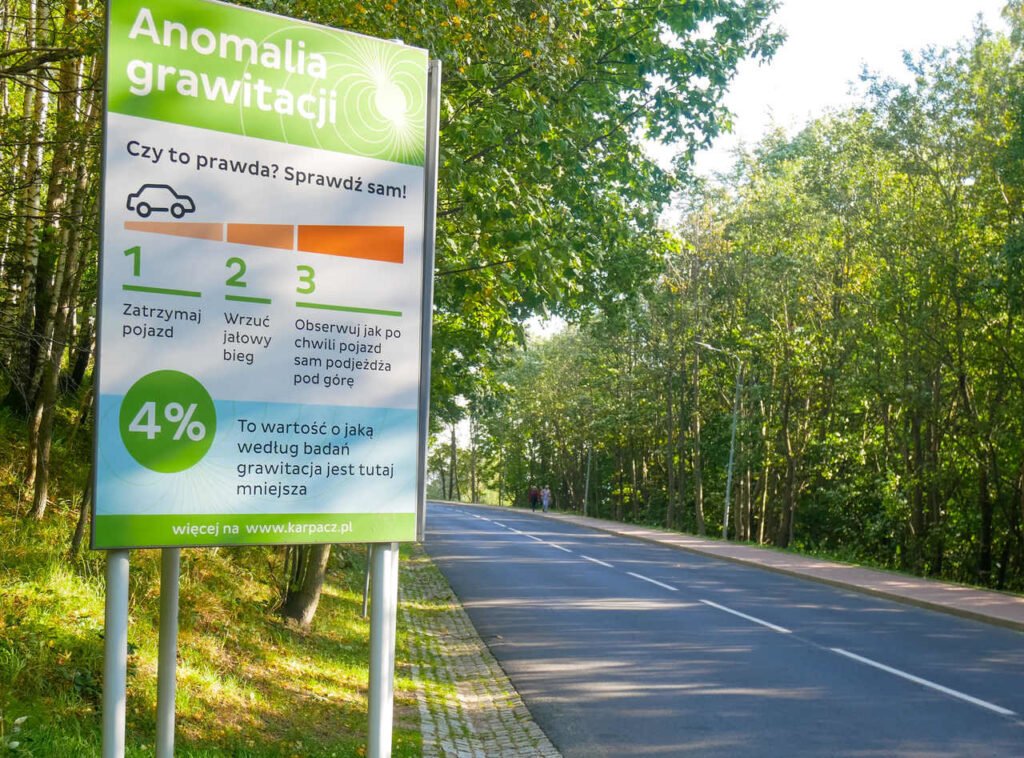
Wild Waterfall (3.5km away)
Not far from the Place of Gravitational Anomaly, there is the picturesque Dziki Wodospad – one of the most atmospheric places in Karpacz, perfect for a photo session. Although it looks like a natural waterfall, it is actually an anti-rubble dam created on the Łomnica River.
It was built at the same time as the dam in the center of Karpacz and has an important protective function – its task is to stop stones and trees carried by the water, especially during heavy rainfall. Thanks to this, it limits the effects of sudden river surges, which in the past caused floods and destruction in the region.
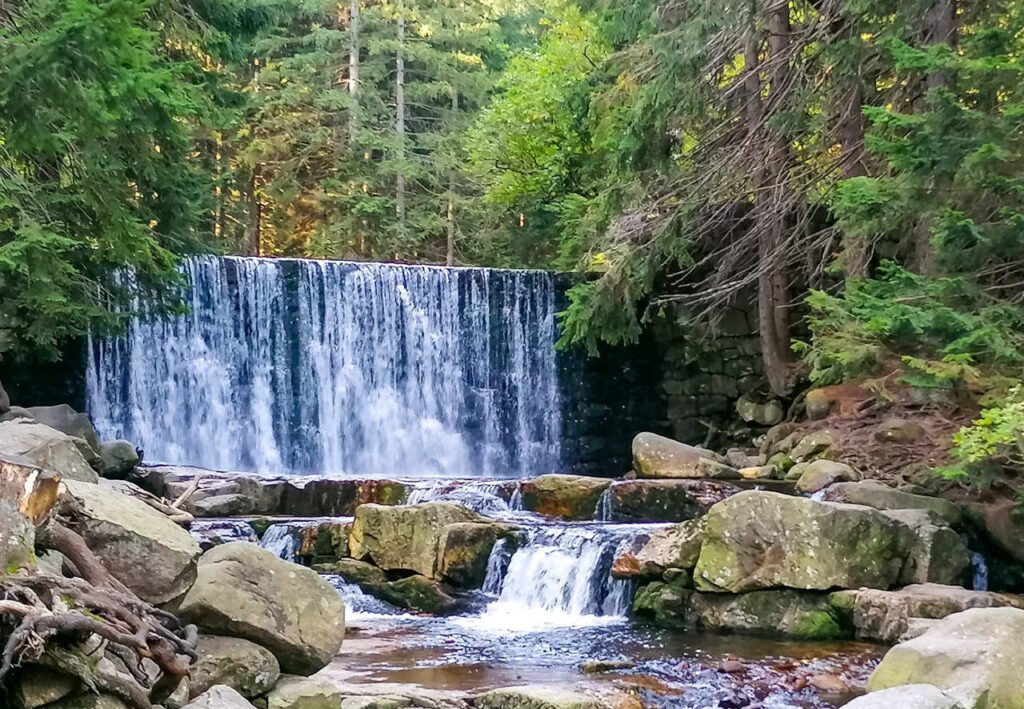
Cable car to Kopa (3.6km away)
Want to conquer Śnieżka, but are worried about your lack of fitness, are travelling with small children or are limited in time? Take the cable car to Kopa – it is the fastest and easiest way to get close to the Queen of the Sudetes.
The cable car journey takes just 7 minutes and ends at an altitude of 1,377 m above sea level. From there, it is only a 2.5 km walk to the summit of Śnieżka. Kopa is also a popular place among skiers – this is where numerous ski trails begin, attracting winter sports enthusiasts.
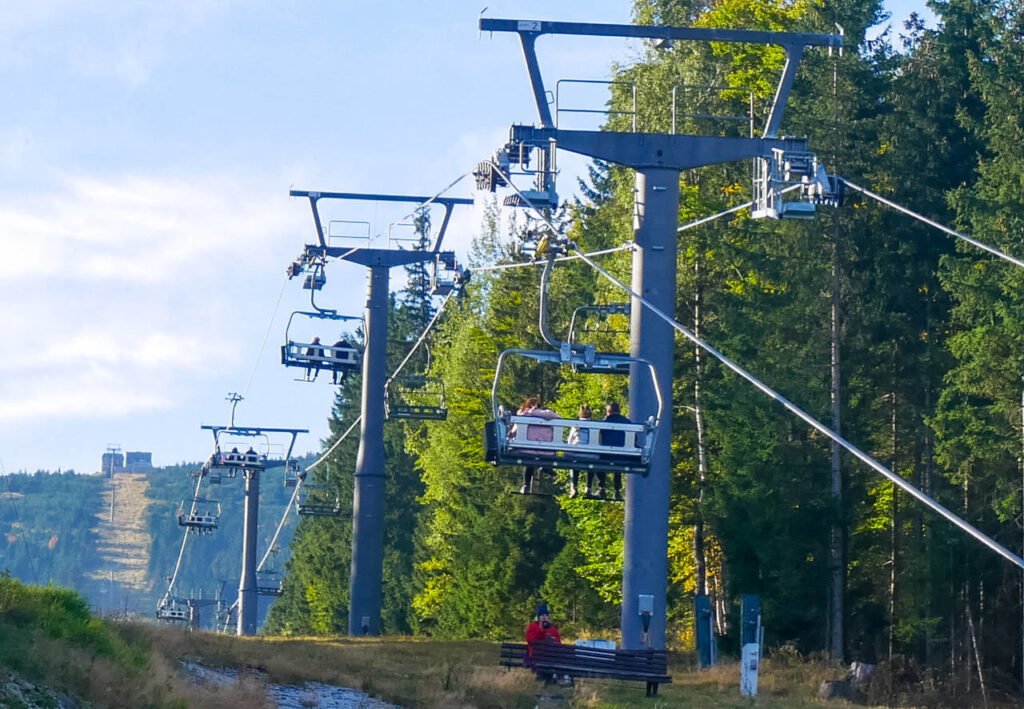
Pilgrims and Sunflower (5.8km away)
Are you coming to Karpacz to discover the charms of the Karkonosze Mountains? You can choose from many picturesque trails, which, in addition to breathtaking views, also offer unique natural attractions.
Following the yellow trail from the Wang Temple, it is impossible to miss the impressive rock formations rising above the treetops. These are the Pilgrims – a group of three massive monadnocks and several smaller boulders, the height of which reaches 25 meters. They were created from Karkonosze granite, shaped by the forces of nature.
Continuing the hike along the same trail, after about 20 minutes you will reach one of the most characteristic rocks in the Karkonosze Mountains, visible from almost the entire Jelenia Góra Valley. The Słonecznik, measuring 12.5 meters, owes its name to the sun – at noon it was located exactly above the rock, serving the residents of Przesieka, Borowice and Podgórzyn as a natural clock.
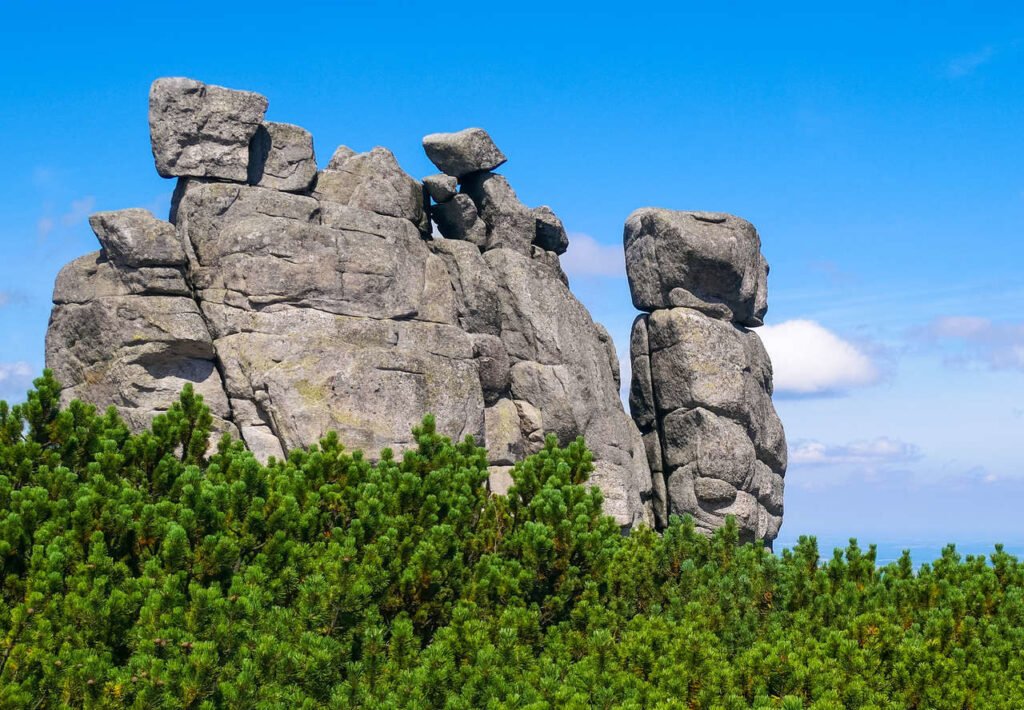
Weathering and erosion gave Słonecznik a shape resembling a human figure, which became the source of many legends. One of them says that it is a petrified devil. According to a story from Karkonosze, he wanted to fill Wielki Staw with stones to harm Liczyrzepa. The plan was to flood the Jelenia Góra Valley, but the devil missed the sunrise and was transformed into a rock with the sound of the Angelus bells.
Cauldron of the Great Pond (7.1km away)
Sunflower is also located on the trail connecting Szklarska Poręba with Karpacz. This route, leading along the main ridge of the Karkonosze Mountains, is called the Polish-Czech Friendship Road and stretches from Szrenica to Przełęcz Okraj.
If you turn left at the height of Sunflower, after a while you will see the impressive Cauldron of the Great Pond. Its central point is Wielki Staw – the largest glacial lake in the Karkonosze Mountains, created after the glacier retreated. It covers an area of 8,321 ha and is one of the most picturesque elements of the Karkonosze landscape.
The Great Pond is an area under strict nature protection due to its unique flora and fauna. As a result, it cannot be approached, but it can be admired from the edge of Cauldron of the Great Pond, from where there is a spectacular view of this unique place.
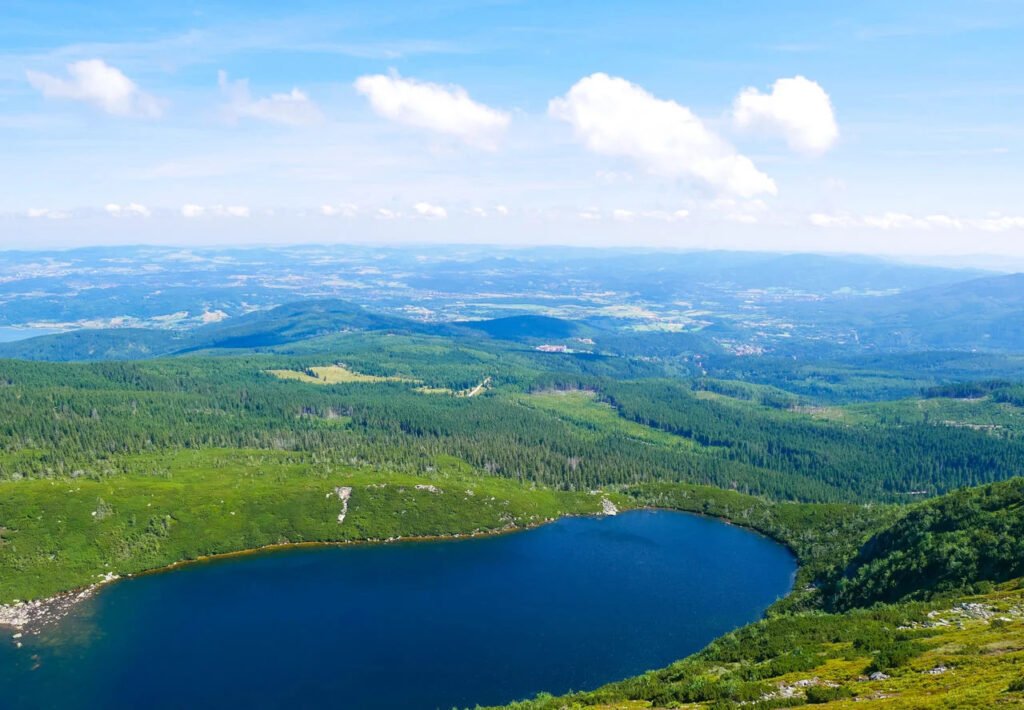
Cauldron of the Little Pond (8.3km away)
The Viewpoint above the Cauldron of the Little Pond is a place you can’t miss – it offers one of the most beautiful views in the entire Karkonosze. Located above the Cauldron of the Little Pond, it offers a breathtaking panorama that is worth capturing in a photo.
This is the only place from which you can capture Little Pond, Samotnia, Strzecha Akademicka and Śnieżka in one photo. And that’s just the beginning – the view stretches much further, encompassing the wide expanses of the Karkonosze.
The easiest route leading to this viewpoint is the red trail from Cauldron of the Great Pond. It is worth stopping here, resting and feasting your eyes on one of the most beautiful panoramas in the region.
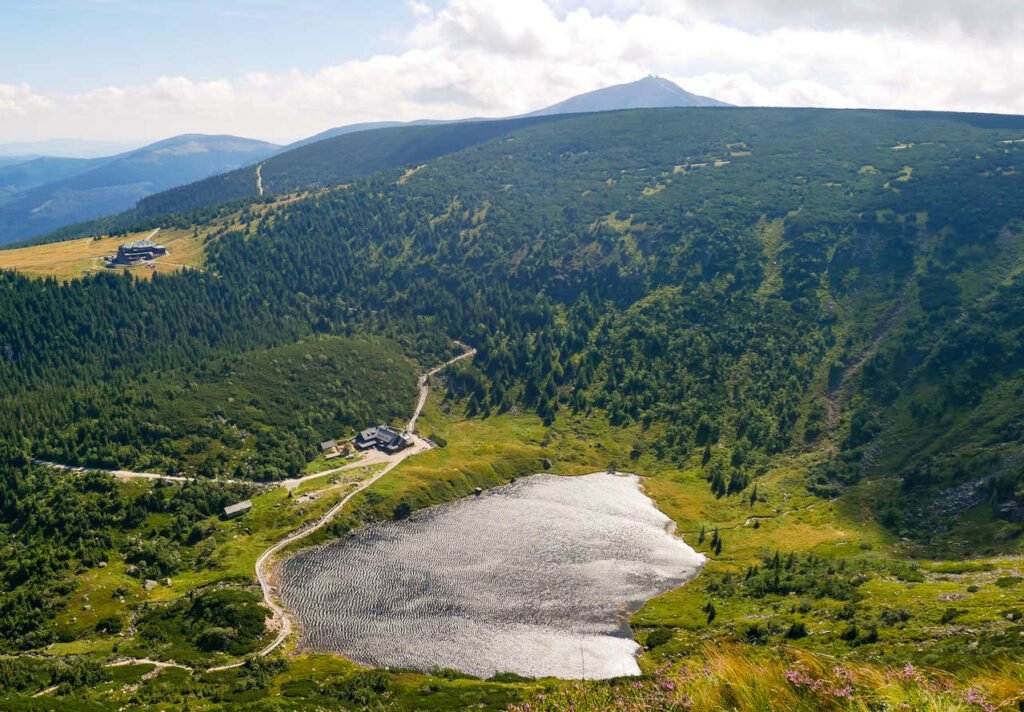
Schronisko "Samotnia" (w odległości 6,8km)
Unlike Cauldron of the Great Pond, you can walk to Cauldron of the Little Pond – and it is definitely worth it. It is one of the most picturesque places in the Karkonosze Mountains, reminiscent of landscapes straight from the Tatras or the Alps.
Cauldron of the Little Pond is surrounded by majestic rock walls about 200 meters high, and its bottom is filled with the crystal clear waters of Little Pond – a glacial lake with an area of 2,881 ha.
Right on the shore, in perfect harmony with the surroundings, there is the Samotnia shelter – one of the oldest in Poland. The first building on Little Pond existed already in 1670. Today, Samotnia is not only a place to spend the night or have a warm meal, but above all a shelter with an extraordinary atmosphere, which delights with its atmosphere and views.
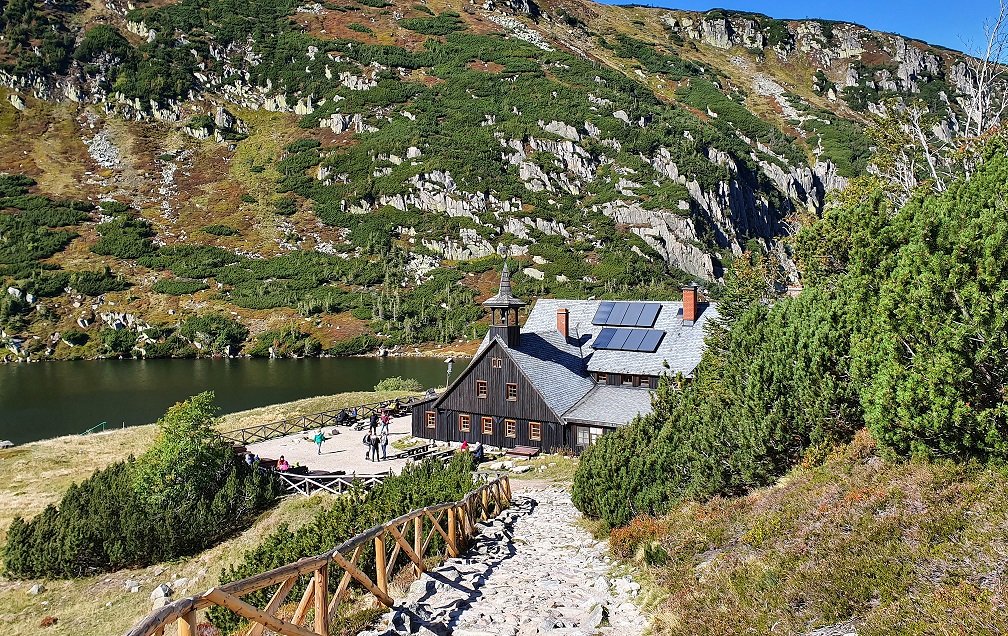
The easiest way to get to Samotnia is the blue trail leading from the Wang Temple – the walk takes about 1.5 hours. You can also go down to it from the Burnt Watchtower, leaving the red trail and after about 30 minutes of walking along the blue trail you will find yourself on the shore of Little Pond.
"Time, like a spinner, has once again unwound autumn from the distaff and once again wound it onto the reel. Up above the meadows on the ridge of the Karkonosze, the blows of the wind were heard, like the dull snorts of empty horns. And down below, gusts of wind swept the bedding from the villagers' barns and scattered it around the area. Between the village cottages, the bare branches of fruit trees hung down to the ground. And here and there, the double blows of flails on the threshing floors could be heard. Indian summer had arrived in the Jelenia Góra Valley."
~ Carl Hauptmann~
In the vicinity of Karpacz
along with the distances from Zielonego Wzgórza
Kowary (7,5km away)
Karpacz is an excellent base for exploring the surrounding towns. To the east of it is Kowary – one of the oldest settlements in the Jelenia Góra Valley, whose origins date back to the 12th century. It was here that iron ore deposits were discovered, which influenced the development of the city.
One of the main attractions of Kowary is the Podgórze Mine – a former uranium mine, where you can explore the history of the region and the extraction of this raw material itself. It is also worth visiting the Kowary Adits – Liczyrzepa Mine, which offers an equally fascinating journey into the depths of the earth.
For lovers of architecture and culture, the Park of Miniature Monuments of Lower Silesia will be a great choice, where in one place you can admire models of the most important Lower Silesian buildings. In turn, the Museum of Sentiments will take visitors back in time, presenting everyday objects from past decades. It is also worth visiting the Kowary Palace, which hides many stories and secrets of this unique town.
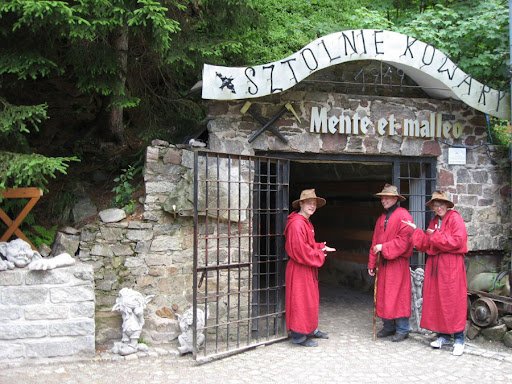
Szklarska Poręba (27km away)
Szklarska Poręba competes with Karpacz for the title of the most popular town in the Karkonosze Mountains. The competition is fierce, as both towns offer numerous unique attractions.
In Szklarska Poręba, there is the Kamieńczyk Waterfall – the largest on the Polish side of the Karkonosze Mountains, which delights with its three-level cascade. It is also a great place for lovers of active recreation. The bicycle routes in the area are very popular, and Szklarska Poręba is considered one of the best places in Poland for cross-country skiing.
One of the most spectacular destinations for trips are Śnieżne Kotły – two impressive glacial cirques, which delight with their steep walls and alpine landscape. This is a must-see for anyone who wants to discover the wild beauty of the Karkonosze Mountains.
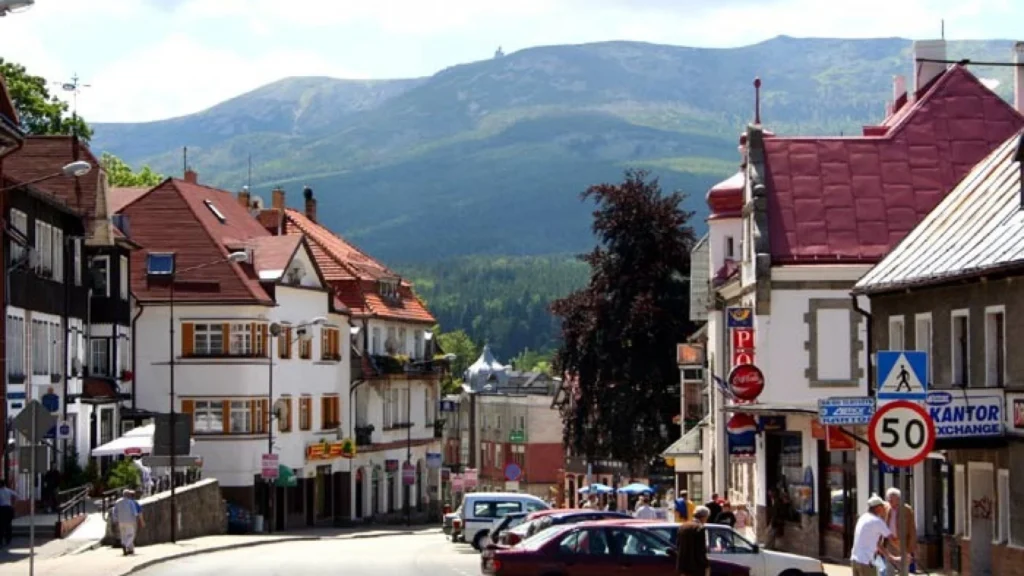
Jelenia Góra (16km away)
The largest city in the Jelenia Góra Valley is Jelenia Góra, often overlooked by tourists heading to Karpacz. It’s a shame, because it’s a city full of charm and interesting attractions that are definitely worth visiting.
Jelenia Góra boasts a picturesque market square, surrounded by colorful tenement houses, numerous historic buildings, as well as interesting museums and churches. Walking around the city, you can discover its rich history and unique atmosphere, which combines architectural heritage with a modern atmosphere. It’s a great place to rest before continuing your journey to the Karkonosze Mountains.
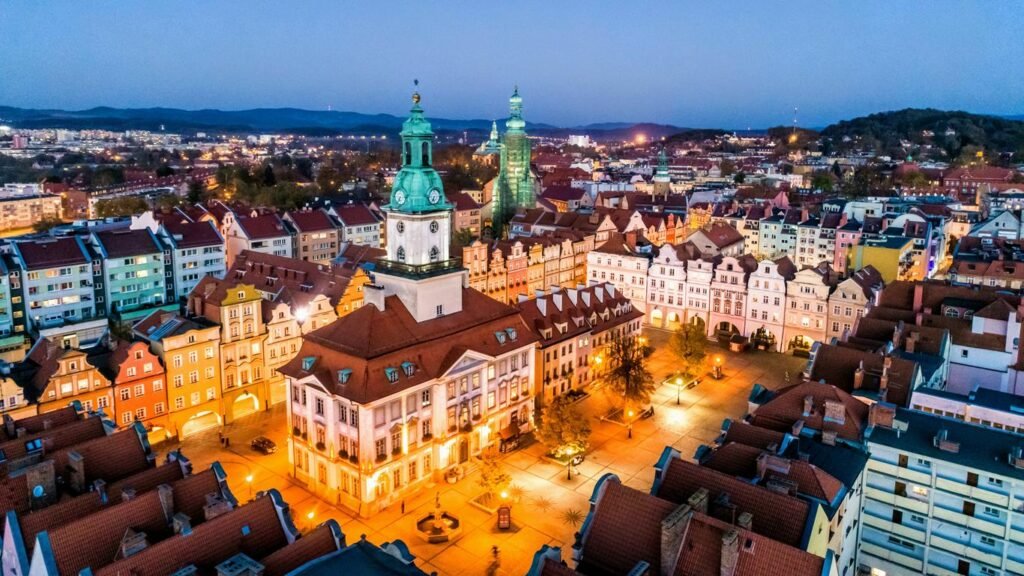
Cieplice (17,3km away)
Although Cieplice Śląskie-Zdrój has been part of Jelenia Góra since 1976, it has retained its unique spa atmosphere. According to legend, the local hot springs were already known in the 12th century. Today, Cieplice is the oldest spa in Poland and the one that offers the warmest thermal water.
To enjoy the benefits of Cieplice waters, you don’t need a referral to a sanatorium – just visit Termy Cieplickie, where you can relax in the thermal pools and SPA zone.
In addition to the healing waters, Cieplice also delights with well-maintained parks and numerous historic buildings, which add charm and historical character to this place. It is an ideal place for a quiet walk and a moment of respite surrounded by beautiful architecture.
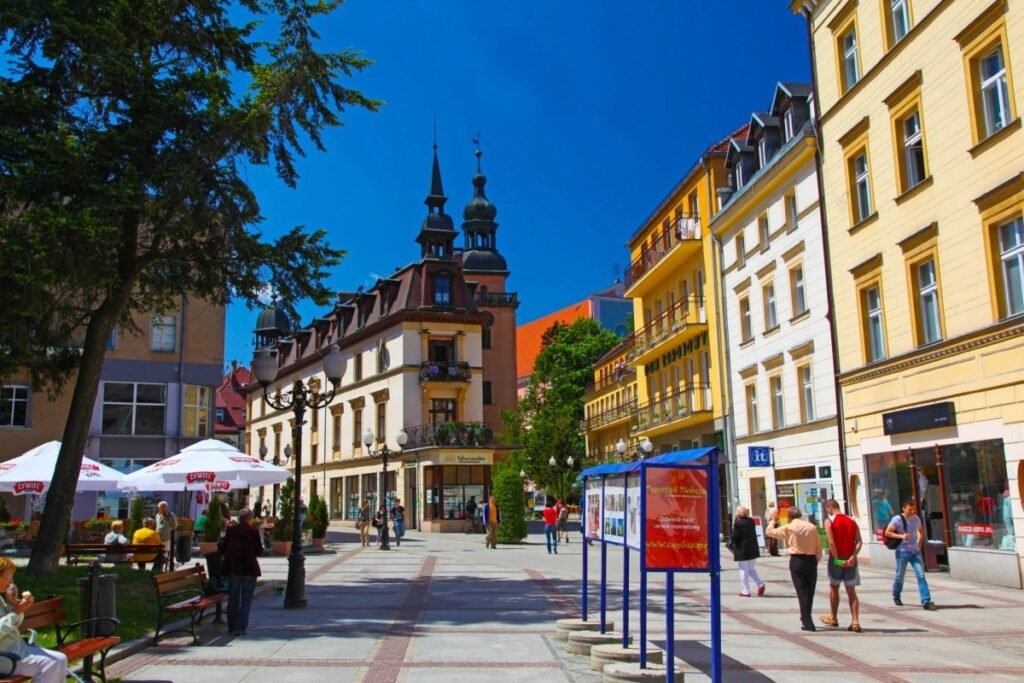
Valley of Palaces and Gardens of the Jelenia Góra Valley (9km away)
The Jelenia Góra Valley is not only picturesque mountains and charming towns, but also impressive palaces and gardens, which give the region a unique character. There are as many as 30 extraordinary residences in the vicinity of Karpacz – from Gothic castles, through Renaissance manors, Baroque palaces, to Classicist estates.
One of the most unique places in the region is the Valley of Palaces and Gardens, which delights not only with its architecture, but also with the landscape parks surrounding it. These areas full of old trees and garden buildings are an ideal place for walks and discovering the historical gems of Lower Silesia.

